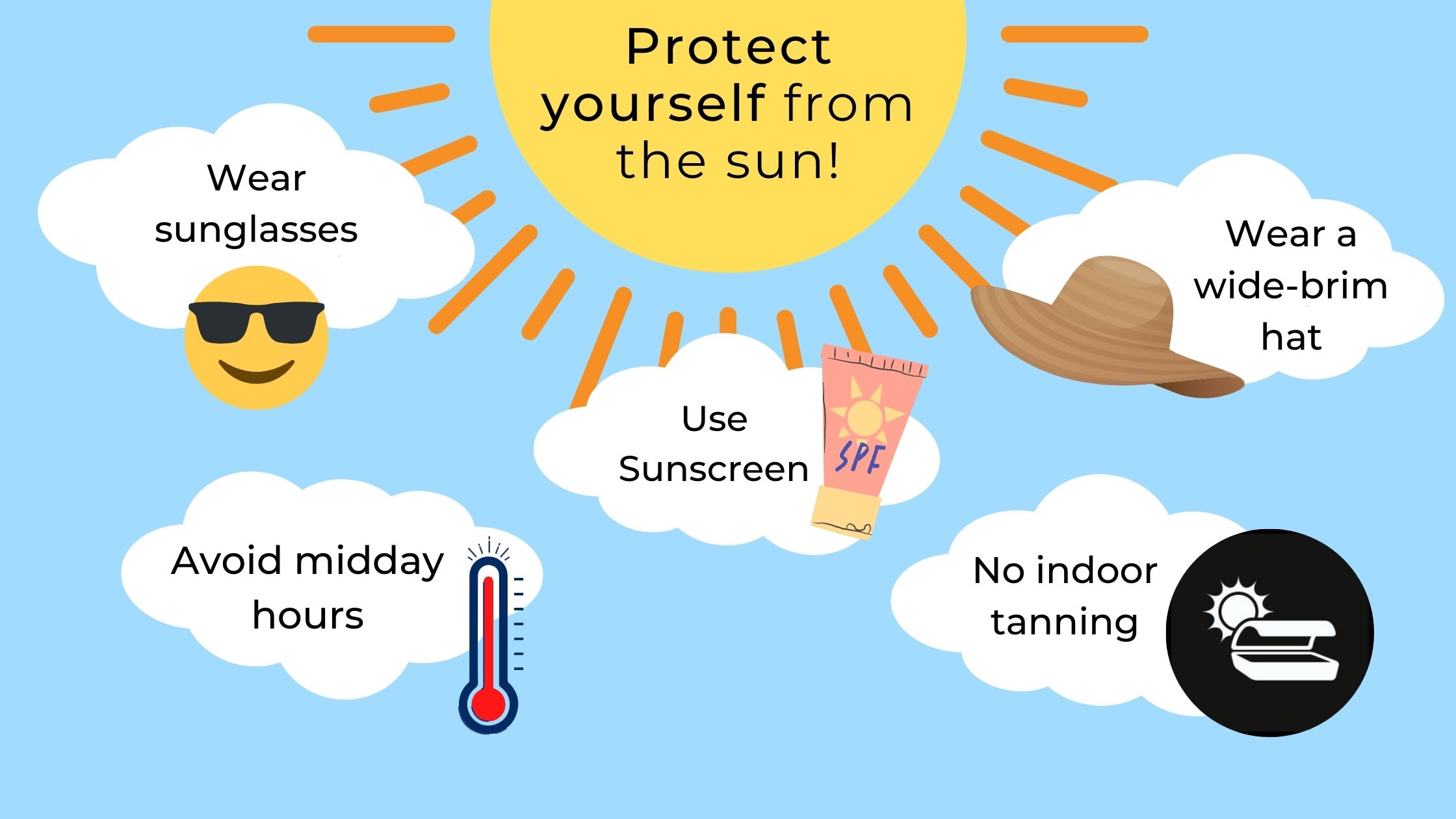Skin Cancer

**Disclaimer**
All of this information is not encouraging you to avoid the sun. Humans need sunlight for general health reasons! Being in the sun tells our bodies to produce vitamin D, which supports bone health. It also helps boost levels of serotonin, a hormone that helps stabilize the mood and promotes feelings of wellbeing and happiness! The outdoors welcomes us to be physically active promoting both physical and mental health. But, you should not enjoy the sun at the expense of your health.
So we implore you… protect yourself and enjoy those sunny days!
Skin Cancer: The Basics
Usually caused by skin cell mutations from sun (ultraviolet, UV) rays, skin cancer is the abnormal growth of skin cells. Types of skin cancer are determined by where the disease begins. The Center for Disease Control and Prevention (CDC) notes it as the most common cancer in the country!
Reducing your exposure to and protecting yourself from ultraviolet light is the BEST way to prevent skin cancer!
Basal Cell Carcinoma is the first most common type of skin cancer. Usually, it looks like a flesh-colored, pearl-like bump, or a pinkish patch of skin. The bumps usually form on the head, neck, and arms, but they can form anywhere on the body. Frequent visits to the tanning salon or sun exposure are the main causes of this kind of skin cancer.
Squamous Cell Carcinoma is the second most common type, and often looks like a firm, red bump, or a scaly patch. The cancer usually forms on the chest, arms, back, face, neck, and rim of the ear (skin that gets the most sun exposure).
Melanoma is the deadliest form of skin cancer because it has the highest potential to spread. It starts to develop within a mole or it appears as a dark spot that looks very different from the rest of the skin.
Overexposure to ultraviolet light from the sun or artificial sources (like tanning bed) is the main cause of skin cancer.
Anyone can contract this disease, but the following is a list of characteristics put you at higher risk:
- A lighter natural skin color
- Skin that burns, freckles, reddens easily, or becomes painful in the sun
- Blue or green eyes
- Blond or red hair
- Certain types and a large number of moles
- A family history of skin cancer
- A personal history of skin cancer
- Older age
A change in your skin is the most common sign of skin cancer. This could be a new growth, a sore that doesn’t heal, or a change in a mole.
Because not all skin cancers look the same, we provided a list of signs of the different types of skin cancer previously listed, pulled directly from the American Cancer Society:
Basal Cell Carcinoma
- Flat, firm, pale or yellow areas, similar to a scar
- Raised reddish patches that might be itchy
- Small translucent, shiny, pearly bumps that are pink or red and which might have blue, brown, or black areas
- Pink growths with raised edges and a lower area in their center, which might have abnormal blood vessels spreading out like the spokes of a wheel
- Open sores (that may have oozing or crusted areas) and which don’t heal, or heal and then come back
Squamous Cell Carcinoma
- Rough or scaly red patches, which might crust or bleed
- Raised growths or lumps, sometimes with a lower area in the center
- Open sores (that may have oozing or crusted areas) and which don’t heal, or heal and then come back
- Wart-like growths
Melanoma and the “ABCDE” Rule
- Asymmetry - a part of the spot does not match the other part
- Border – the edges of the spot are ragged, notched, blurry, or just irregular
- Color – the spot has different shades (brown, black, maybe even red, white, or blue) all over
- Diameter – the spot is larger than one-fourth inch across, about the size of a pencil eraser
- Evolving – the spot is changing in size, shape, or color
Because sun rays can reach you when it is not sunny (like through clouds and off reflections surfaces like water, sand, cement, and even snow), protection from ultraviolet radiation is important all year round!
The CDC recommends following these tips for the best protection against exposure to ultraviolet rays:
- Stay in the shade, especially during the middle of the day
- Sun rays are hottest during the late spring and early summer in North America
- Wear clothes that cover your arms and legs
- Wear a hat with a wide brim to shade your face, head, ears, and neck
- Wear sunglasses that wrap around and block both UVA and UVB rays (see photo below)
- Use sunscreen with a sun protection factor (SPF) of 15 or higher and broad spectrum
(UVA/UVB) protection
- Reapply sunscreen every TWO hours, especially if after sweating or swimming (you may not need to do this if you are indoors and away from windows
- Avoid indoor tanning
The earlier a patient is diagnosed for skin cancer, the more treatable the cancer becomes. Leaving the bumps untreated allows them to grow deeper into the skin, causing damage to the nerves and bones, more spreading of the cancer, and even disfigurement.
Not all skin cancers fit these descriptions. Visit the American Cancer Society for more information!
![]()
For more information on skin cancer, visit:
American Academy of Dermatology Association
Mayo Clinic - Skin Cancer Overview
Center for Disease Prevention and Control (CDC) - Skin Cancer Index
Some of the links on this page may require additional software to view.

